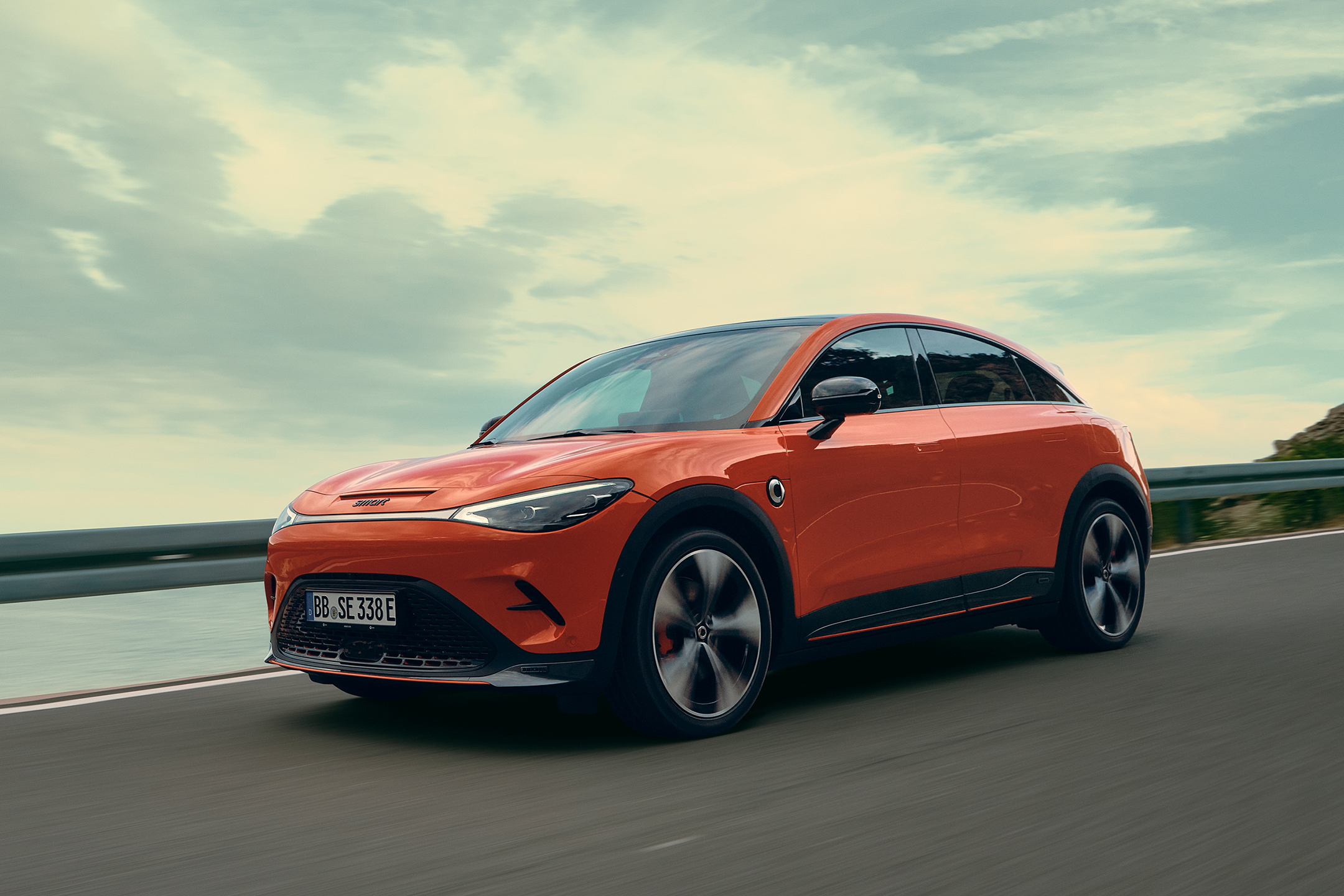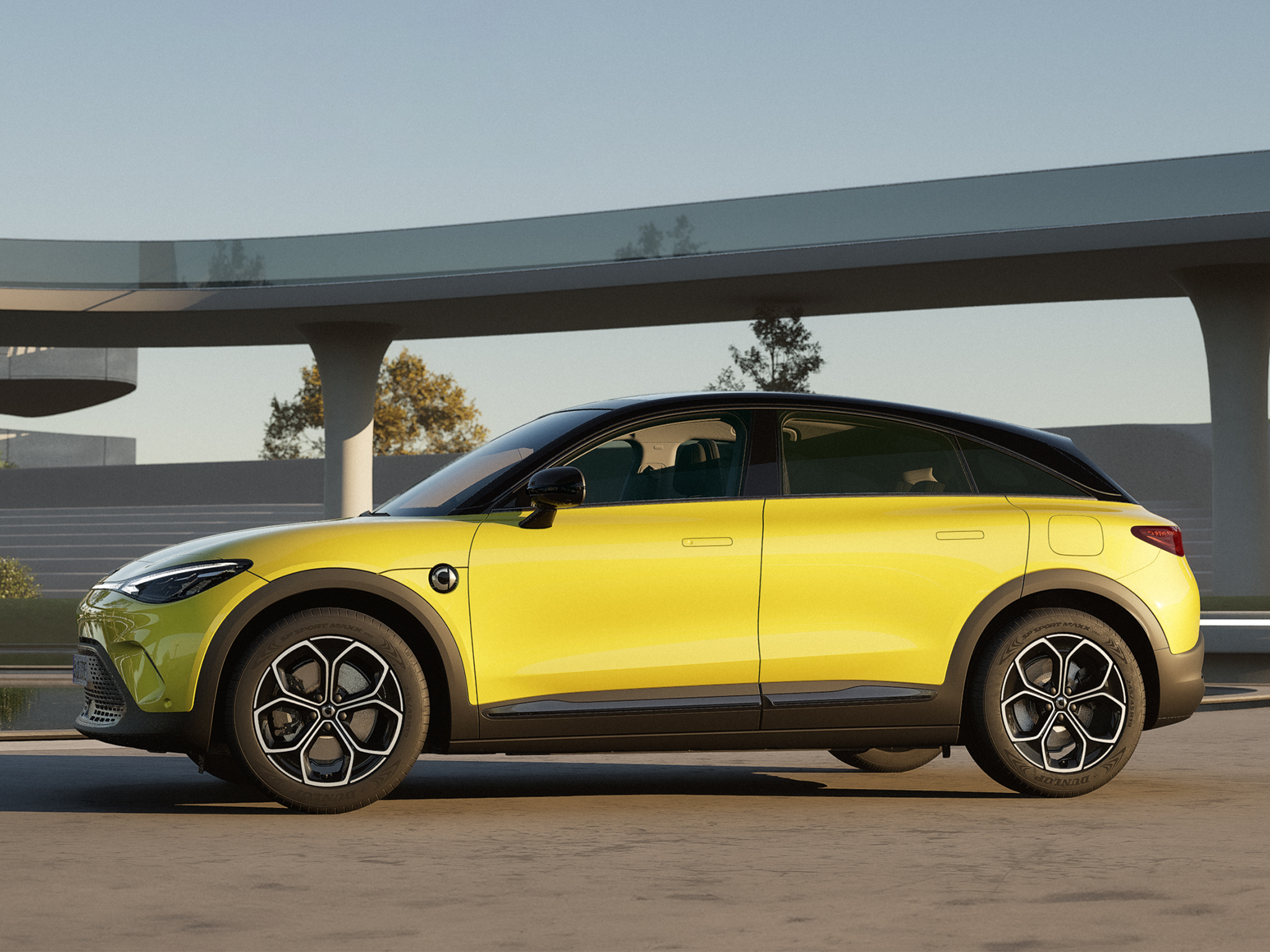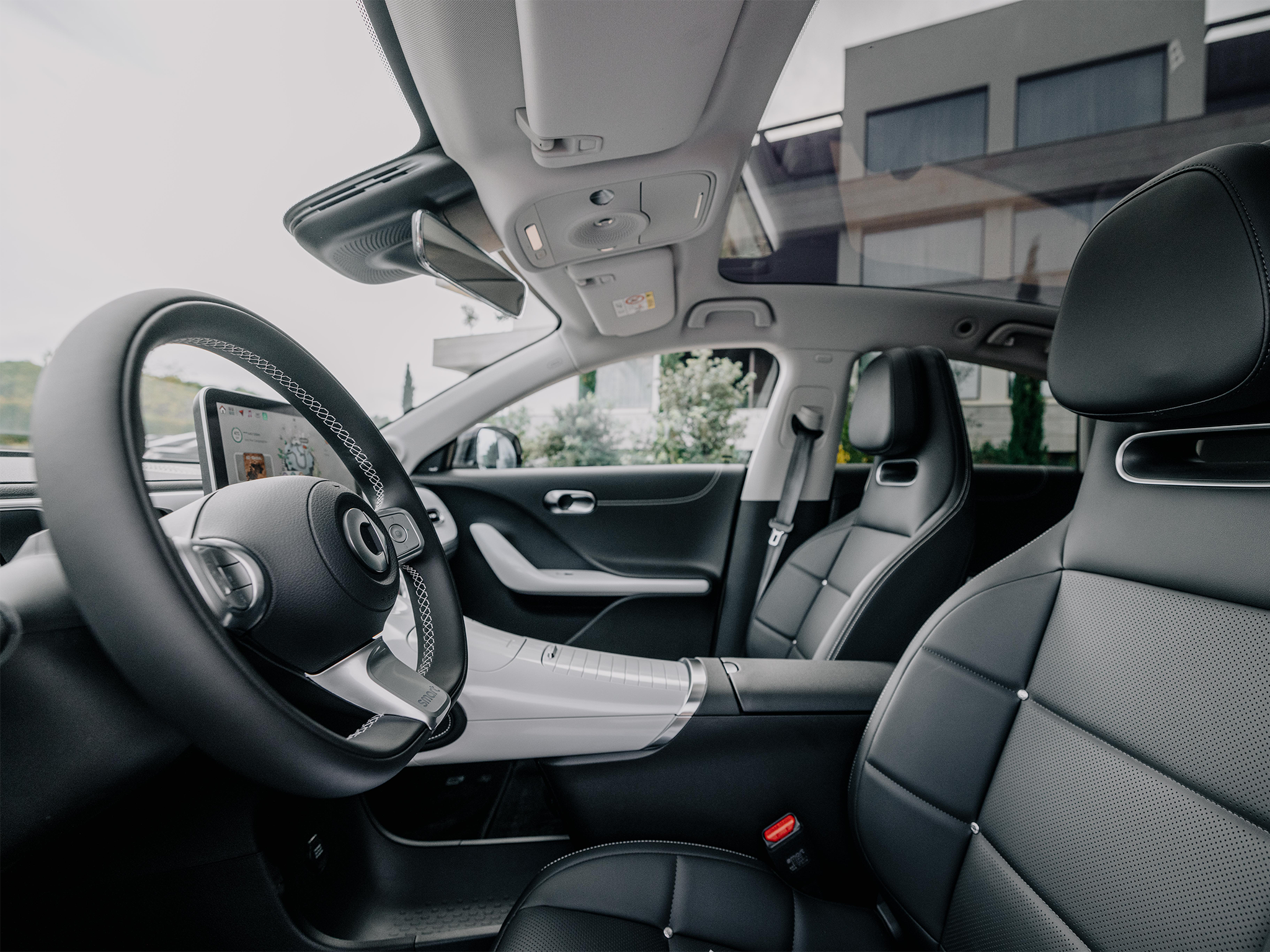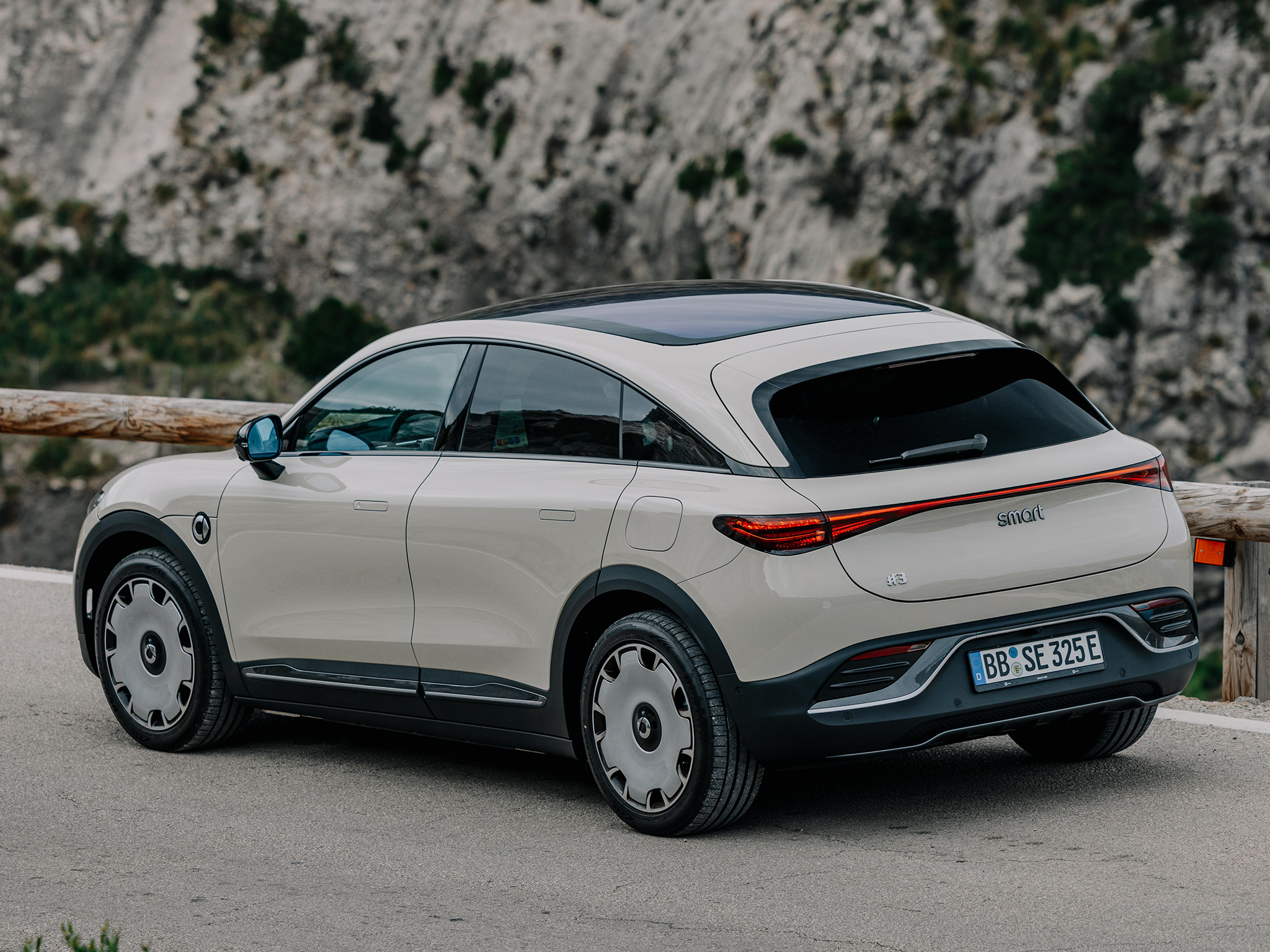Smart #3 review: Fast-charging electric coupe-SUV with a 270 mile range
Our test car’s stubborn satnav and dicey cruise control spoiled this otherwise fun compact electric SUV

The Independent's Electric Vehicles Channel is sponsored by E.ON Next.
The Smart #3 (pronounced “hashtag three”) is a coupe version of the Smart #1, which itself is a fairly generic Chinese-manufactured compact SUV.
Neither car has much to do with the little Smart city cars you may remember, aside from the badge and the fact that the maker is still part-owned by Daimler AG, better known as Mercedes-Benz. The other parent of the new generation Smart models is Geely, a Chinese conglomerate that also owns Volvo, Polestar and Lotus.
Those familiar with Mercedes models will recognise the distinctive switchgear for lights, wipers and indicators, but the look and feel of the touchscreen is distinctly different and more typical of the playful approach seen on various Chinese-sourced models wearing a variety of badges.
Our car, the Premium model, drove reasonably well, being rear-wheel drive and well balanced, with typically brisk EV performance. The steering could be sharper, but at least the brakes are efficient.
The Smart #3 is a rare sight on the roads and frankly probably a bit too idiosyncratic for many, while the Brabus version, with its supercar performance cloaked in slightly blobby bodywork, is even more of an oddball. But that wasn’t the main issue with our test car.
How we tested
We borrowed the Smart #3 for ten days and used it as any owner would: mixed driving, albeit dominated by long motorway work. It also had a trip to the tip and ran us around town for some errands. For that latter task we’d have rather had an old Smart ForTwo, but that’s another controversy. We covered about 400 miles.
Smart #3: From £32,950, Smart.com

Independent rating: 6/10
- Pros: Intriguing design; attractive Mercedes-ish coupe styling; reasonable range; comfortable and very fast charging capability
- Cons: Software issues; unreliable sat-nav and assisted driver systems; better value can be found elsewhere
- Price range: £32,950–£45,450
- Battery size: 49 to 62 kWh
- Maximum claimed range: 193 to 273 miles
- Miles per kWh: 3.7
- Maximum charging rate: 130 to 150 kW
- Charging cost per 100 miles on E.ON Next Drive: £1.81
Battery, range, charging, performance and drive
The Smart #3 comes in various flavours. There’s the basic model, known as the Pro, with the smaller battery pack, a single motor driving the rear wheels and shorter range. The Pro+ and Premium are endowed with a punchier 62kWh pack and all-wheel drive options (via dual electric motors, one per axle). The Brabus is basically a software-tuned version of the twin-motor, big battery configuration – built to deliver Ferrari performance (at least on paper), but with correspondingly more restricted range. So there’s a wide variety of real-world outcomes in terms of efficiency from these permutations.
Our Smart #3 Premium is probably the optimal choice for most purposes and delivered about 250 miles on a charge – not bad for a lot of motorway journeys in fairly cool weather. Zero to 60 mph came up in a respectable 5.8 seconds, and the Smart #3 never felt short of dynamic ability.
Fast charging using the M1 services’ hyper-quick terminals was extremely impressive, delivering around 250 miles per hour of charging. Smart says it will go up to more than 300 miles per charge hour and, in our experience, it took about half an hour to get from 20 per cent to 80 per cent charge.
Mind you, that kind of fast public charging tends only to be found on the motorways (some, such as the M25 and M40, have very long gaps between services), and are costly. So the success of long commutes depends very much on which motorways you’re using, if any.
If you enjoy novelty, then you’ll like the interior. The Smart #3’s cabin is a melange of European and Chinese styles. The switchgear for lights and wipers is minimalist Mercedes, but the big touchscreen is quirky, complete with some sort of animated big cat, possibly a leopard or a cheetah, prowling around the screen looking rather pleased with itself.
Unlike us, the creature never seemed that bothered about being taken on some highly dubious detours by the sat-nav.
The centre console is set very high and intrudes into the driver’s space a little too much, even for those with a modest inside leg measurement. Knee room was a touch compromised. You get the impression that style has been granted a little too much status, compared to function.
Smart’s charging software, screen information and capacity is superior to that of most rivals we’ve tried. Cabin materials are bright, quality seems high and there were no quibbles about fit and finish.
Space in the back is surprisingly good, given the coupe lines. With the seats down, there was space enough to take some end-of-life furniture for recycling (in appropriately green transport). At a maximum of 370 litres, there's actually more room than in the Smart #1. The boot is more spacious than that of its Geely group cousin, the Volvo EX30, but some way behind the Peugeot e-2008, a highly capable, albeit more conventional rival, and the (costlier) Skoda Enyaq Coupe.

Technology, stereo and infotainment
The Smart #3 is fully competitive on paper, enjoying a full complement of driver assistance and a well-specced Beats sound system.
In our testing however, the Smart #3 is disappointing. Most alarming was the unpredictable automatic cruise control, which would occasionally decide that the speed limit had changed – it hadn’t – and slam the brakes on pretty hard to bring speed down from 70mph to 50mph. This was in the absence of roadworks or similar restrictions.
Most modern cars can “see” road signs, weighing that data with what they gather via the satellite navigation system, and all are capable of making errors. But the Smart #3 was one of the least reliable we’ve come across since this technology started to become routine a few years ago.
Connecting your smartphone and Google Maps would solve some of the problems, and our car may have been an exception, but it didn’t really inspire confidence.
Naturally, there’s no on/off button, so you switch the thing on by putting it in gear and turn it off by locking it via a button on the door handle. But that’s not so unusual these days.
The other irritant was the built-in satnav, which tended to crash and issue some highly eccentric instructions. For example, our car would direct us to leave the motorway only to rejoin it again immediately at the same junction. Ignore this wandering route and the satnav becomes unresponsive, as though offended by your defiance. If you then cancel your route, you need to re-enter the address and then obey its commands without demur.
Smart says that over-the-air software fixes will address these issues, but we’d recommend paying close attention to the satnav and cruise control features if you’re taking a test drive.
Prices and running costs
The Smart #3 starts at £32,590, rising to £45,350 for the Brabus variant, complete with discreet body kit. Leasing starts at about £420 per month for the basic Pro, which should suit most. The Brabus is really a niche product. offering less of everything except acceleration, according to the numbers. On the plus side, it has a 5 (out of 5) star NCAP rating.

Smart #3 rivals
FAQs
How long does it take to charge?
The Smart #1 has a maximum charge rate of 130kW or 150kW, depending on the battery capacity. Use an equally powerful charger and Smart says it will fill from 10 to 80 per cent in under 30 minutes (roughly right during our testing). A full charge from a wallbox at home will take about 10 hours, or as little as three hours if you have the wiring required for a more powerful 22kW charger.
How much does it cost - is it worth it?
With a starting price of about £32,000, the Smart #3 is reasonably competitive, but less so as you move up through the ranks, where the pricier versions look like poorer value next to the (admittedly more expensive) Skoda Enyaq Coupe, a popular and able adversary. But the EV market is a little distorted at the moment, and there are more bargains to be had on the more mainstream brands such as Citroen, and particularly on nearly new examples. Shopping around is more vital than ever. Residuals are not clear at the moment.
Does Smart replace batteries for free?
The Smart #3 has a regular warranty of three years and unlimited miles. The battery has its own warranty that lasts for eight years or 125,000 miles, whichever comes first. If the battery fails in that time or its maximum capacity falls below 70 per cent, it’ll be fixed or replaced without cost.
The verdict: Smart #3
Smart assures us that over-the-air software fixes will be available for the kinds of shortcomings we encountered on our test drive. If so, and if you’re up for something a little different, then the Smart #3 might suit you well. If you take it for a test drive, make sure you try the satnav and the adaptive cruise control, preferably on a motorway with roadworks.



Join our commenting forum
Join thought-provoking conversations, follow other Independent readers and see their replies
Comments